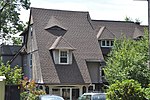Beaconsfield Terraces Historic District
Buildings and structures in Brookline, MassachusettsColonial Revival architecture in MassachusettsHistoric districts in Norfolk County, MassachusettsHistoric districts on the National Register of Historic Places in MassachusettsNRHP infobox with nocat ... and 2 more
National Register of Historic Places in Brookline, MassachusettsRenaissance Revival architecture in Massachusetts

The Beaconsfield Terraces Historic District is a residential historic district at 11–25, 33–43, and 44–55 Garrison Rd. and 316–326, 332–344, and 350–366 Tappan Street in Brookline, Massachusetts. It encompasses a collection of architecturally distinctive row houses that were built between 1889 and 1892 by a single developer, and represent a unique early success in condominium ownership. The district was listed on the National Register of Historic Places in 1985.
Excerpt from the Wikipedia article Beaconsfield Terraces Historic District (License: CC BY-SA 3.0, Authors, Images).Beaconsfield Terraces Historic District
Claflin Road,
Geographical coordinates (GPS) Address Nearby Places Show on map
Geographical coordinates (GPS)
| Latitude | Longitude |
|---|---|
| N 42.3375 ° | E -71.136388888889 ° |
Address
Claflin Road 11
02447
Massachusetts, United States
Open on Google Maps








